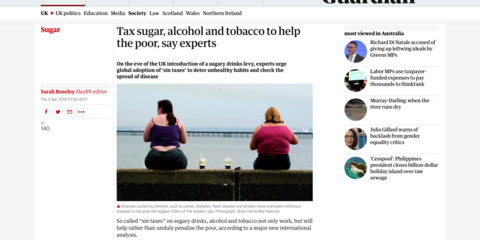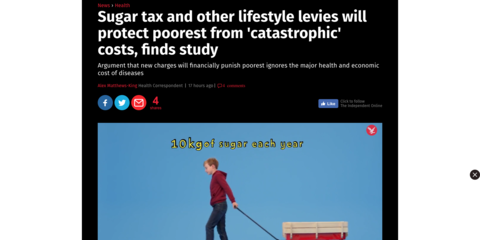
The Lancet: Taxes on soft drinks, alcohol and tobacco are a powerful response to rising rates of chronic diseases
- Non-communicable diseases (NCDs) such as stroke, heart disease, diabetes, chronic respiratory disease and cancer are major drivers of poverty worldwide
- Poor and uninsured households are more likely to incur catastrophic health care costs from NCDs, and are more likely to forgo care for chronic health problems compared to higher income households
- Taxes on unhealthy products can produce major health gains for the poorest in society, especially if tax revenues are used to fund pro-poor programmes
- Prevention and treatment of NCDs is linked to more than half of the 17 Sustainable Development Goals, proving central to achieving many 2030 targets
Taxes on soft drinks, alcohol and tobacco are a powerful response to rising rates of non-communicable diseases (NCDs) worldwide, according to the most comprehensive analysis to date of evidence on expenditure, behaviour and socio-economic status, published today in The Lancet.
Bringing together data from across the globe, the five papers present strong evidence that taxes on unhealthy products have the potential to produce major health gains among the poorest in society who are disproportionately affected by NCDs. The evidence helps counter fears that such taxes will necessarily disproportionately harm the poor.
Non-communicable diseases such as cancer, heart disease and diabetes are responsible for 38 million deaths each year, 16 million of these are among people aged under 70. The Sustainable Development Goal NCD target (SGD 3.4) is to reduce deaths from NCDs by a third by 2030 and promote mental health.
“Non-communicable diseases are a major cause and consequence of poverty worldwide,” says Dr Rachel Nugent, RTI International (Seattle, USA) and Chair of The Lancet Taskforce on NCDs and economics. “Responding to this challenge means big investments to improve health care systems worldwide, but there are immediate and effective tools at our disposal. Taxes on unhealthy products can produce major health gains, and the evidence shows these can be implemented fairly, without disproportionately harming the poorest in society.”1
The Lancet Taskforce on NCDs and economics is a partner of the WHO’s Independent High-Level Commission on NCDs2, and will be launched at the WHO NCD Financing meeting in Copenhagen (9-11 April).
In a linked Comment, American economist Larry Summers, co-chair of the Task Force on Fiscal Policy for Health, which is also a partner of the High-Level Commission, writes that the analysis provides more evidence to dispel notions that are outdated, misleading, or simply wrong, saying that it “helps clear the air over one of the most common obstacles to taxing the consumption of goods that kill us—namely, the argument that such taxes are regressive.”
Professor Franco Sassi, author, Imperial College Business School (London, UK) adds: “No amount of money, however small, is trivial for low income households, especially in low income countries. But, the extra tax expenditures involved should not deter governments from implementing a policy that may disproportionately benefit the health and welfare of lower-income households. Governments must carefully assess the available evidence from their own countries and look at the tax system as a whole, including investing tax revenue in pro-poor programmes or subsidising healthy alternative products.”1
Worldwide, non-communicable diseases are major drivers of poverty
High quality evidence from 283 international studies including data from India, China and Brazil, shows that low socio economic status is consistently associated with higher rates of non-communicable disease in low and middle income countries.
Furthermore, evidence from 66 international studies on 13 chronic diseases, concludes that NCDs place a substantially higher economic burden on low income households compared to higher income households, especially in the absence of health insurance. Uninsured patients experienced a 2-7 fold increase in the odds of catastrophic health spending2 compared with insured patients.
Even with protective health insurance, high levels of co-pays or a lack of coverage for specific treatments mean households can often experience catastrophic expenditure. In China, for example, 1 in 3 patients (37%) with stroke are impoverished from paying for medical treatment and even among people with health insurance, over half (53%) experienced financial catastrophe.
Professor Louis Niessen, author from the Liverpool School of Tropical Medicine (UK) says: “Health inequalities due to non-communicable diseases are increasing globally both within and between countries. The poor, with already shorter life expectancies and bearing the brunt of undernutrition, malnutrition, childhood diseases, major infections, and pregnancy-related conditions, are the most likely to be affected by non-communicable diseases.”1
“Poverty and economic hardship have many causes, but this major body of evidence highlights the ruinous and long-term economic burdens of non-communicable diseases on households. An important policy response is to provide financial protection through tax-financed health care and social health insurance programmes, and within these programmes, provide for the subsidisation of interventions that are cost-effective,” adds author Professor Stephen Jan, George Institute for Global Health (Sydney, Australia).1
In a linked Comment, Dr Tedros Adhanom Ghebreyesus, Director General of the WHO, writes: “Every year, almost 100 million people are pushed into extreme poverty because of out-of-pocket health spending, and the costs of treating NCDs are a major contributor to this global scandal. Nobody should lack access to health services because they cannot afford to pay. Failing to provide adequate coverage for NCDs can widen inequities not only in health, but in all other social and economic domains.”
Taxes can produce major health gains for poorest in society
By analysing consumption patterns, expenditure and responsiveness to price changes across different income groups, the Taskforce provides a comprehensive analysis of existing data to help governments understand the potential impact of taxes, and inform whether their use is justified. The analysis is based on available data from 13 countries (Chile, Guatemala, Panama, Nicaragua, Albania, Poland, Turkey, Tajikistan, Tanzania, Niger, Nigeria, India and Timor-Leste).
Firstly, evidence shows that high income households generally consume more, and spend more, on alcohol, soft drinks and snacks, compared to low income households. Patterns for tobacco are less consistent. In India, for instance, wealthier households spent seven times more on alcohol and three times more on soft drinks and snacks compared to poorer households (see paper 4, figure 1 for full data).
Increased taxes on unhealthy products will therefore affect a larger number of high-income households than low-income households, meaning that the revenues generated by taxes will come disproportionately from high income households.
Tax policies can also be designed to influence this effect. Since high income consumers are more likely to buy more expensive beverages, especially alcohol, an alcohol policy based on unit price may be less of a burden on low income household, compared to a policy based on volume.
Secondly, as a proportion of total household expenditure, low income households tend to be more greatly affected by price changes compared to high income households, although the effect varies. The analysis also shows that low income households respond to price changes more readily than higher income households.
In the UK, the response to the possible introduction of a minimum price for alcohol was estimated to be 7.6 times larger in the poorest households, compared to the wealthiest. In Mexico, the introduction of a soft drinks tax resulted in an average of 4.2L less of soft drinks purchased per person, with a 17% decrease in purchases among lower income groups, and almost no change in higher income groups.
Indeed, the authors model the consequences of a 50% increase in the price of cigarettes in Lebanon (paper 4, table), and estimate that twice as many smokers in the poorest households would quit compared to the richest (20200 vs 11300), with a third (31%) of the increased tax revenue borne by the richest group and 7% by the poorest.
The authors point to examples of pro-poor programmes in Mexico where part of the revenue from the soft drinks tax is used to provide drinking water for children in public schools. In Thailand and the Philippines alcohol and tobacco tax revenues are ear-marked specifically for public health programmes (paper 4, appendix).
Dr Nugent adds: “The evidence suggests that concerns about higher taxes on tobacco, alcohol, and soft drinks harming the poor are overstated. Some degree of taxation on tobacco is common in many countries, and while we are starting to see progress on alcohol taxes, there is much more governments should be doing – in both high and low-income countries – to consider the careful introduction of taxes on other unhealthy products like soft drinks and snacks. Price policies such as taxes will be a key part of the response to rising rates of non-communicable diseases.”1
Prevention and treatment of non-communicable diseases is central to achieving many of the SDGs
Progress on non-communicable diseases will have a central role in determining the success of at least nine of SDG targets. The SDG target on NCDs (SDG 3.4) links to targets on reducing poverty (SDG 1), hunger (SDG 2), improving health and wellbeing (SDG 3), education (SDG 4), gender equality (SDG 5), work and economic growth (SDG 8), reduced inequalities (SDG 10), sustainable cities and communities (SDG 11), and sustainable production and consumption (SDG 12).
The economic benefits of investing in NCDs are considerable. Cardiovascular diseases account for nearly half of all NCDs deaths every year (17.7 million). The WHO package of ‘best buys’ includes interventions to reduce smoking and salt intake, and pharmaceutical interventions for the prevention and treatment of ischaemic heart disease and stroke6.
The cost of implementing the package in 20 countries where 70% of cardiovascular deaths occur, is estimated at US$120 million for the period to 2030, equivalent to an additional US$1.50 per person. By 2030, this could prevent 15 million premature deaths, making it almost possible to achieve the SDG target of reducing premature mortality from NCDs by a third by 2030. Importantly, the return of investment is 5.6 for economic returns and 10.9 if social returns are also included.
Dr Melanie Bertram, author, World Health Organisation (Switzerland), says: “Effective and low-cost interventions including reducing smoking, salt reduction in food, and available medication are still not implemented widely enough in low and middle-income countries. Our analysis shows that investing in cardiovascular disease prevention and intervention is integral to achieving the SDG target to reduce premature deaths from NCDs.”1
“Controlling non-communicable diseases will contribute to economic growth, and investing in prevention and control offers a high return on investment for countries of all income levels,” says author Professor Robert Beaglehole, University of Auckland (New Zealand). “NCDs are a common threat to achieving several of the SDG targets, and efforts to tackle these conditions should be a priority for ministries of health and finance in any country.”1
- Read the full series of papers at The Lancet Taskforce for NCDs and economics
Notes
- Quotes direct from authors and cannot be found in the text of the articles
- The WHO’s Independent High-Level Commission on NCDs is co-chaired by Sania Nishtar, the Presidents of Finland, Sri Lanka, and Uruguay, and the Minister of Healthcare of the Russian Federation. The additional Commission partnerships are with the Bloomberg Philanthropies Taskforce on Fiscal Policy for Health and Chatham House.
- A formal meta-analysis was impossible because of the variable definitions used – for instance, SES indicators include household and individual income, asset-based and consumption measures and educational attainment.
- Different thresholds for catastrophic health spending have been used. The most common are that out of pocket health care costs comprise over 40% of annual non-subsistence income (household food expenditure) or 30% of total annual income.
- Bangladesh, DR Congo, Myanmar, Egypt, India, Indonesia, Nigeria, Pakistan, Philippines, Ukraine, Vietnam, Brazil, China, Iran, Mexico, South Africa, Thailand, Turkey, Poland and Russia.
- These include interventions to reduce smoking (taxes, advertising bans, health warnings, indoor smoking ban), reducing salt intake (reformulation, labelling, mass media campaigns, low salt meals in public institutions), and pharmaceutical interventions for the prevention and treatment of ischaemic heart disease and stroke.






